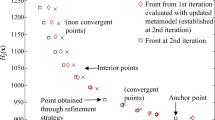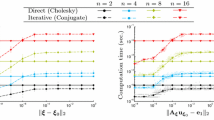Abstract
The use of Surrogate Based Optimization (SBO) is widely spread in engineering design to find optimal performance characteristics of expensive simulations (forward analysis: from input to optimal output). However, often the practitioner knows a priori the desired performance and is interested in finding the associated input parameters (reverse analysis: from desired output to input). A popular method to solve such reverse (inverse) problems is to minimize the error between the simulated performance and the desired goal. However, there might be multiple quasi-optimal solutions to the problem. In this paper, the authors propose a novel method to efficiently solve inverse problems and to sample Quasi-Optimal Regions (QORs) in the input (design) space more densely. The development of this technique, based on the probability of improvement criterion and kriging models, is driven by a real-life problem from bio-mechanics, i.e., determining the elasticity of the (rabbit) tympanic membrane, a membrane that converts acoustic sound wave into vibrations of the middle ear ossicular bones.










Similar content being viewed by others
References
Aernouts J, Couckuyt I, Crombecq K, Dirckx J (2010) Elastic characterization of membranes with a complex shape using point indentation measurements and inverse modelling. Int J Eng Sci 48:599–611
Aernouts J, Soons J, Dirckx J (2010) Quantification of tympanic membrane elasticity parameters from in situ point indentation measurements: validation and preliminary study. Hear Res 263:177–182
Barton R (2005) Issues in development of simultaneous forward-inverse metamodels. In: Proceedings of the Winter simulation conference, pp 209–217. doi:10.1109/WSC.2005.1574253
Bonnans J, Gilbert J, Lemaréchal C, Sagastizábal C (2006) Numerical optimization: theoretical and practical aspects. Springer, Berlin
Couckuyt I, Declercq F, Dhaene T, Rogier H (2010) Surrogate-based infill optimization applied to electromagnetic problems. Advan Des Optimiz Microwave/rf Circuits Systems (special issue) 20(5):492
Couckuyt I, Gorissen D, DeTurck F, Dhaene T (2010) Inverse surrogate modeling: output performance space sampling. In: 13th AIAA/ISSMO Multidisciplinary Analysis Optimization Conference
Crombecq K, Dhaene T (2010) Generating sequential space-filling designs using genetic algorithms and monte carlo methods. In: Simulated evolution and learning (SEAL-2010), pp 80–84
Dam E, van Husslage B, den Hertog D, Melissen J (2007) Maximin Latin hypercube designs in two dimensions. Operat Res 55(1):158–169
Decraemer W, Funnell W (2008) Anatomical and mechanical properties of the tympanic membrane, chronic otitis media. Pathogenesis-oriented therapeutic management. Kugler Publications, The Hague
Elkhouri N, Liu H, Funnell W (2006) Low-frequency finite-element modelling of the gerbil middle ear. J Assoc Res Otolaryngol 7:399–411
Forrester A, Sobester A, Keane A (2008) Engineering design via surrogate modelling: a practical guide. Wiley, Chichester
Gan R, Sun Q, Feng B, Wood M (2006) Acoustic-structural coupled finite element analysis for sound transmission in human ear—pressure distributions. Med Eng Phys 28:395–404
Gibbs M, Mackay DJC (1997) Efficient implementation of gaussian processes. Tech Rep, Department of Physics, Cavendish Laboratory, Cambridge University
Gorissen D, Crombecq K, Couckuyt I, Demeester P, Dhaene T (2010) A surrogate modeling and adaptive sampling toolbox for computer based design. J Mach Learn Res 11:2051–2055, http://sumo.intec.ugent.be/
Hadamard J (1902) Sur les problèmes aux dérivées partielles et leur signification physique. Tech Rep 49–52, Princeton University Bulletin
Jones D, Perttunen C, Stuckman B (1993) Lipschitzian optimization without the lipschitz constant. Optimiz Theory Appl 79(1):157–181
Jones DR (2001) A taxonomy of global optimization methods based on response surfaces. Global Optimiz 21:345–383
Jones DR, Schonlau M, Welch WJ (1998) Efficient global optimization of expensive black-box functions. J Global Optimiz 13(4):455–492. doi:10.1023/A:1008306431147
Kleijnen J, van Beers W, van Nieuwenhuyse I (2011) Expected improvement in efficient global optimization through bootstrapped kriging. Journal of Global Optimization 51:1–15. doi:10.1007/s10898-011-9741-y
Picheny V, Ginsbourger D, Roustant O, Haftka R (2010) Adaptive designs of experiments for accurate approximation of a target region. Mech Des 132(7):9
Ponweiser W, Wagner T, Vincze M (2008) Clustered multiple generalized expected improvement: A novel infill sampling criterion for surrogate models. In: Congress on Evolutionary Computation
Sacks J, Welch WJ, Mitchell T, Wynn HP (1989) Design and analysis of computer experiments. Stat Sci 4(4):409–435
Santner T, Williams B, Notz W (2003) The design and analysis of computer experiments. Springer series in statistics. Springer-Verlag, New York
Sasena M (2002) Flexibility and efficiency enhancements for constrainted global design optimization with kriging approximations. Ph.D. thesis, University of Michigan
Schonlau M (1997) Computer experiments and global optimization. Ph.D. thesis, University of Waterloo
Sóbester A, Leary SJ, Keane AJ (2004) A parallel updating scheme for approximating and optimizing high fidelity computer simulations. Struct Multidisciplinary Optimiz 27:371–383(13)
Staum J (2009) Better simulation metamodeling: The why, what, and how of stochastic kriging. In: Proceedings of the Winter Simulation Conference
Wang G, Shan S (2007) Review of metamodeling techniques in support of engineering design optimization. J Mech Des 129(4):370–380. doi:10.1115/1.2429697
Acknowlegments
Ivo Couckuyt and Jef Aernouts are funded by the Institute for the Promotion of Innovation through Science and Technology in Flanders (IWT-Vlaanderen)
Author information
Authors and Affiliations
Corresponding author
Rights and permissions
About this article
Cite this article
Couckuyt, I., Aernouts, J., Deschrijver, D. et al. Identification of quasi-optimal regions in the design space using surrogate modeling. Engineering with Computers 29, 127–138 (2013). https://doi.org/10.1007/s00366-011-0249-3
Received:
Accepted:
Published:
Issue Date:
DOI: https://doi.org/10.1007/s00366-011-0249-3




